page 11
Progressive Thinkers as of 5/8/2020
|
| ||||||||||||||||||||||||||||||||||||||||||||||||||||||||||||||||||||||||||||||||||||||||||||||||||||||||||||||||||||||||||||||||||||||||||||||||||||||
So how are we to account for larger counts of chromosomes in some "lower" forms of life when compared to the whole array of chromosome counts such as for example the 48 for chimps, orangutans, & gorillas, and 46 for later hominids such as present day humans, if not the entire hominid line of descent? Is a larger chromosome count among some small life forms (like the ciliated protozoa with 16,000 chromosomes) a type of internalized gigantism that was seen externally in those animals typically referred (solely) to as Dinosaurs? ( List of organisms by chromosome count)
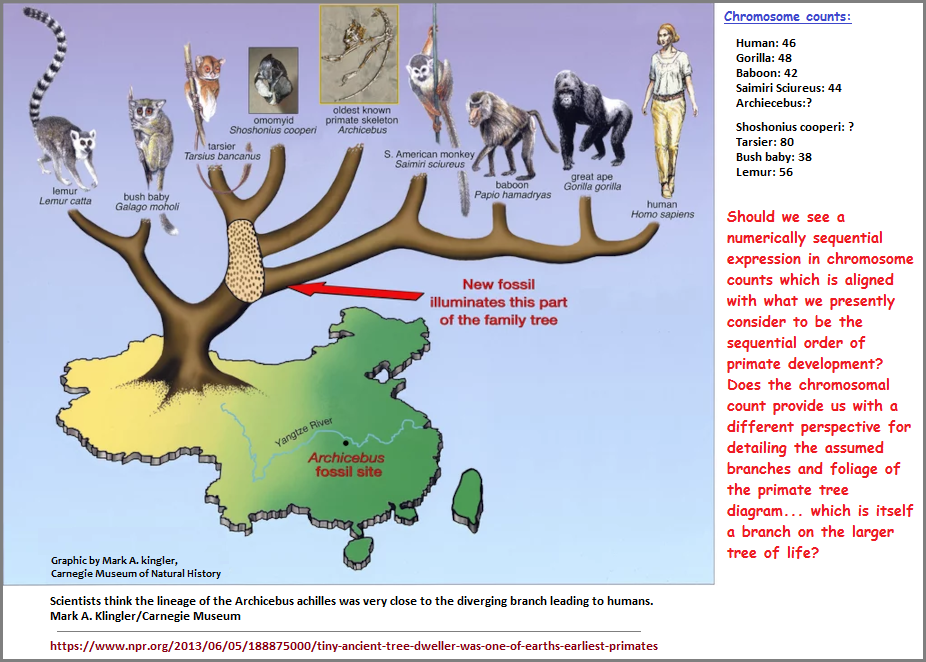
Interestingly, as an aside note, humans as well as Orangutans have all three blood types (A, B, O) in the ABO blood typing system, while Gorillas appear to be exclusively of the B type and Chimpanzees primarily have the A type. (Blood group antigen types and prevalence ). The "RH" factor in blood (designated with a plus or minus sign), was first discovered in the Rhesus monkey. (What is the Rhesus Factor?). The RH factor is said to have evolved out of the Amt molecule in a very distant age, but developed its own separate characteristics through evolution. (Rh proteins vs Amt proteins). Amt is said to exist in every living thing, though not every living thing has actually been analyzed. However, since there are no exceptions as yet to have been found, (apparently) the general practice is to include the idea that something such as Amt exists in all life forms. In other words, assumptions are as frequently used in science as they are in religion, business, government, love, hate, envy, etc... In other words it is an emotional impulse for staking an assertive claim of dominance, though it is frequently labeled a belief, faith or educated guess.
Let's look at a small sorting of chromosome counts, with an emphasis on the primate:
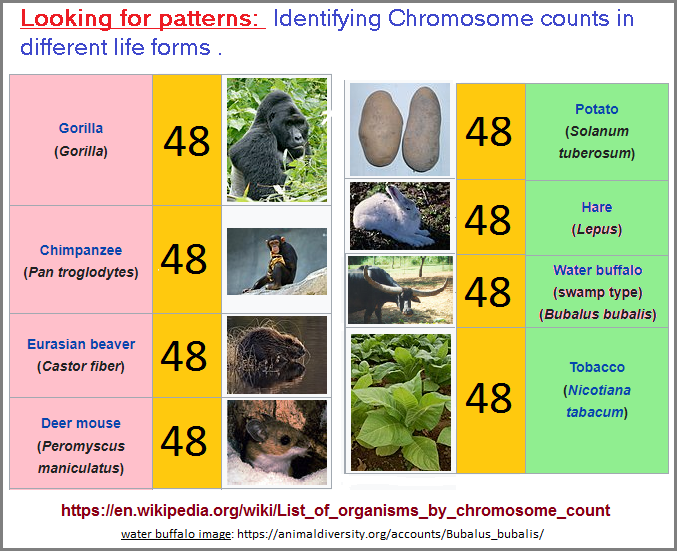
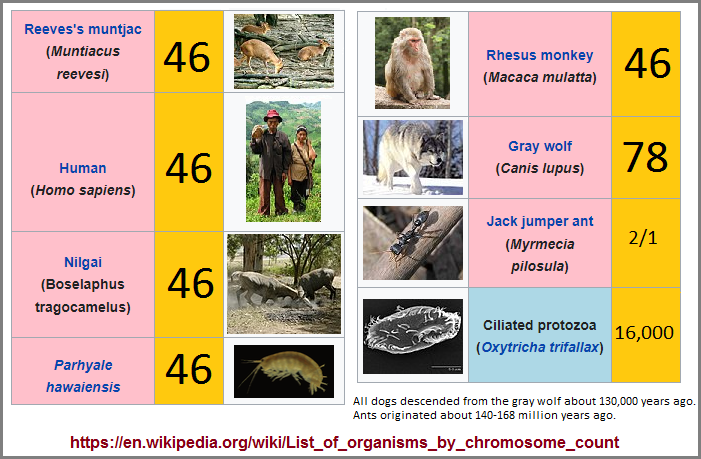
I could not find (in a relatively short search) a list of the chromosome counts for all primates, if such a list even exists since an emphacis to do so (by other reserarchers) may rest somewhere in the rationale that no additional consideration for chromosomal differences need be given; other than as a tertiary consideration without regard to the possibility of such having a larger application in differentiating the primate line of descent. Statistical variations in numerical sequences (or an apparent lact therof), should be accounted for as being the possible product of influences not yet collated nor correlated into some approximate mechanism for such an order... or if nothing more than some reason for the presence of what may be colloquially termed a resulting shotgun distribution of chromosomal values. Whereas we see a Fibonacci sequence in distribution of leaf arrangements, the sequence of numbers in chromosome counts has not been given any attention as to what the overall counts may imply, if anything at all.
It is interesting to see that when one encounters an idea concerning the recognition of a pattern such as the Fibonacci sequence, there generally is no overt socially-expected extension of this to attempt to identify the possible existence of one or more other patterns, though this is in fact a characteristic taking place with many people. They simply do not actively acknowledge that they are looking for one or more other patterns as an activity the brain appears to engage in as a common day to day exercise. Whereas it appears most of us do, we tend to apply the mental exercise on day-to-day themes and not specifics such as when studying a subject. The mental ability and energy exists, it simply is not applied to a subject area one might otherwise label as an exercise which creates the circumstance of personal ownership or establishing a science of an activity not usually described as a science. For example, a person may apply their individualized cognitive architecture on a given job which makes them appear to be greatly informed or "on top" of all concurring sequences of events, even though they may not be the actual owner of a business or hold some defined management position. Others have been described as creating a "science" out of a given practice because within the confines of a given task, they have become quite adept at managing (controlling) any variable which might arise to create a problem for someone not as astute in a given context. In short, whereas the human mind can be quite adept when applied to a given set of occurrences to give the impression that a person is uniquely qualified for a given enterprise, a problem may occur when they try to apply the same mental strategy to another context with different variables whose underlying pattern uses different symbols or labels as references.
The Fibonacci sequence is not the only pattern available to pay witness to, but it appears that the next focus on pattern recognition is in itemizing the presence of various geometric forms such as whorls, spirals, and other rotation-like configurations. I am not talking about human renderings of interpreted patterns involving enumeration, but simple overt patterns being mimicked from a child's perspective of geometry. Whereas adult ideas create various diagrams such as branched trees and various graphic charts referencing activiites such as cellular or molecular growth patterns; a more simpler form of pattern recognition appears to be a repeating excursion into identifying the presence of basic geometric patterns that are later subjected to enumeration. However, the point I want to bring up is that the Fibonacci sequence is not the only recurring pattern which can be viewed numerically, even if artistic geometric designs are preferred by some. It is simply one we usually trip over and becomes subjected to additional math-related exercises such as finding the Golden Ratio. Yet, in this exercise we have a tell-tale indication of what to look for if attempting to find "whole number" representative patterns do not enter into our visual range. The indicator is ratio or proportionality, such as is exhibited by the words gigantism and dwarfism, though one should not always expect to see ratio or proportionality being exhibited by a dichotomy.
In an attempt to account for the presence and/or lack of a sequential numerical line up in chromosome counts, looking only at primates may not provide us with a necessary vantage point for understanding what appears to be a misaligned distribution of values according to a typicallly drawn line-up of primates. In other words, take any "tree-with-branches" illustration of the primate linneage and place their chromosome counts nearby, and we have a lineage whose enumerated chromsome values appear to be a misaligned assortment of different values, with there being exceptions such as in the case when looking directly at the connection between the COG (chimp, orangutan, gorilla) 48 and the "wheel" of the homo lineage with its 46 chromosome count. That is if all those in the homo line share the same count and did not produce some intermittent fluctuation akin to a 'chromosomal missing link'.
If we take the primate linneage and sort it into some numerical order, this may well cause a shift in thinking to view the lineup in a different perspective of development. Different numerical alignments would thus emphacize looking at the linneage of primates from different vantage points instead of off-handedly being impulsively dismissive when first confronting such an idea.
When we find some life forms that we imagine to be more primitive than humans exhibiting a larger chromosome count, are we to interpret that a larger number somehow references a more advanced or less advanced life form, or is there no equitable correlation to be made here? Are primates somewhere in the middle of an overall count of chromsomes when all life forms are considered? Are sequences only valid if we exam two or three closely related species such as gorillas and humans, or does the inclusion of "missing" chromosome counts tell us that there are multiple missing links in the primate chain of events; even if those events are only distantly related? Then again, does the chromosome counts of the different primates offer us a larger insightfulness pertaining not only to the species but all life forms as well, or is it little more than an amusing numbers game for self-distraction?
When we cite chromosome counts for different life forms and claim that a given type of life form subjected to a given type of environment accounts for the different chromosome counts, an attempt must be made to record developmental distributions over time. For example, apparently, primates tend to cluster in equatorial regions, thus subjected to an enclosed type of environmental influence... at least in a macro-scopically viewed generality. Not only distributions of occurrences through a given life form's developmental history must be accounted for, but the different environmental forces which may have prevailed, including larger planetary events such as the rotation rate of the Earth, the position of the moon, atmospherica oxygen content, polar reversals, temperature gradients, geological disturbances, and extraterrestrial interlopings such as meteors (or even aliens if you are of a mind to include them). For example, the rotation rate of the Earth at today's equator is about 1000 miles per hour. Because the Earth was spinning faster in the past, the regional speed of the equatorizl zone would have been similarly faster. So does the occasion for the usage of C4 plants instead of the later thriving C3 plants upon which so many animals (including humans) feed.
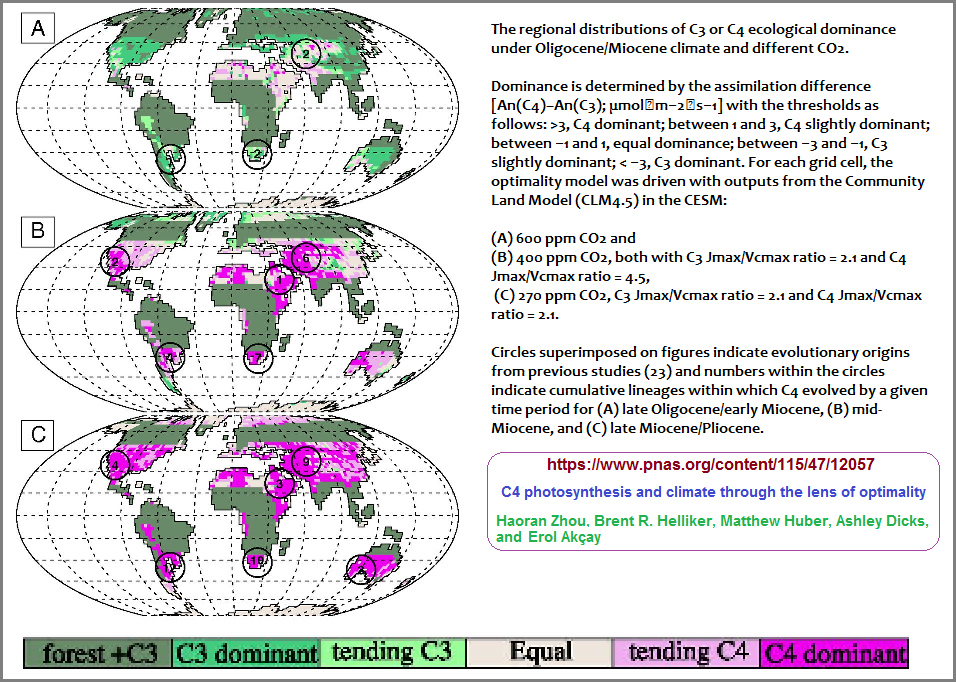
With respect to plants under present day circumstances, there are 3 types of plants based on the three different processes that plants use to fix carbon during the process of photosynthesis. Fixing carbon is the way plants remove the carbon from atmospheric carbon dioxide and turn it into organic molecules like carbohydrates. (Biology Dictionary):
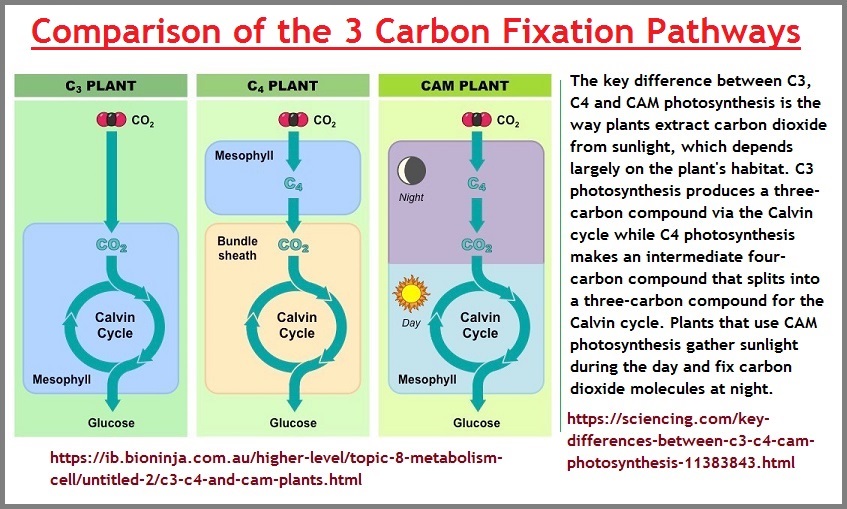
C3 PlantsC4 Plants
- The vast majority of land plants we rely on for human food and energy use the C3 pathway, which is the oldest of the pathways for carbon fixation, and it is found in plants of all taxonomies. Almost all extant nonhuman primates across all body sizes, including prosimians, new and old world monkeys, and all the apes—even those who live in regions with C4 and CAM plants—depend on C3 plants for sustenance.
- Species: Grain cereals such as rice, wheat, soybeans, rye, and barley; vegetables such as cassava, potatoes, spinach, tomatoes, and yams; trees such as apple, peach, and eucalyptus
CAM Plants
- Only about 3% of all land plant species use the C4 pathway, but they dominate nearly all grasslands in the tropics, subtropics, and warm temperate zones. C4 plants also include highly productive crops such as maize, sorghum, and sugar cane. While these crops lead the field for bioenergy, they aren't entirely suitable for human consumption. Maize is the exception, however, it's not truly digestible unless ground into a powder. Maize and other crop plants are also used as animal feed, converting the energy to meat—another inefficient use of plants.
- Species: Common in forage grasses of lower latitudes, maize, sorghum, sugarcane, fonio, tef, and papyrus
Adaptations to Climate Change in C3, C4, and CAM Plants by K. Kris Hirst
- CAM photosynthesis was named in honor of the plant family in which Crassulacean, the stonecrop family or the orpine family, was first documented. This type of photosynthesis is an adaptation to low water availability and occurs in orchids and succulent plant species from arid regions. In plants employing full CAM photosynthesis, the stomata in the leaves are closed during daylight hours to lessen evapotranspiration and open at night in order to take in carbon dioxide. Some C4 plants also function at least partially in C3 or C4 mode. In fact, there's even a plant called Agave Angustifolia that switches back and forth between modes as the local system dictates.
- Species: Cactuses and other succulents, Clusia, tequila agave, pineapple
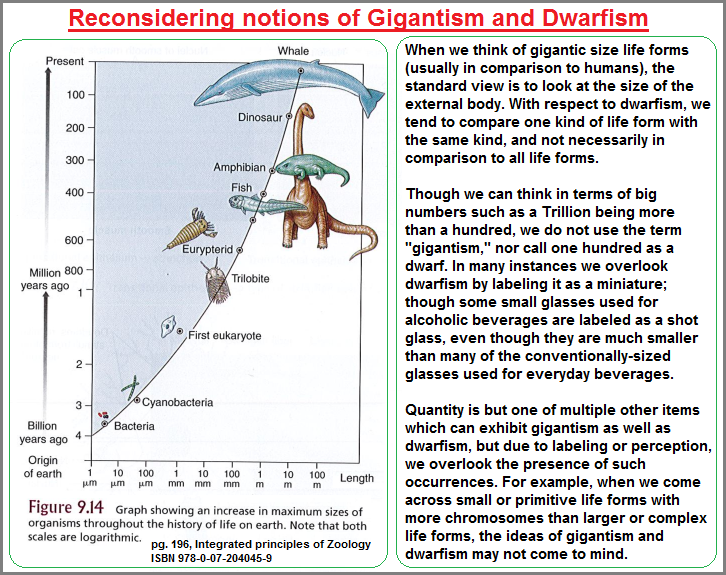
The word "Dinosaur") generally evokes the notion of a very large animal, though there were small, medium and large sizes, and varitions similar to the different sizing categories we append to clothes.) When thinking about what may have caused the large size in Dinosaurs, one can find a variety of ideas. For example:
- Hot climate, profuse vegetation (coupled to a higher metabolic rate), and higher carbon dioxide levels.
- Four theories: (Why Dinosaurs Were So Big by Bob Strauss, July 18, 2019)
- Size Was Fueled by Vegetation
- Self-Defense
- Byproduct of Cold-Bloodedness
- Bony Head Ornaments Led to Larger Size
- ...With body mass increase driven by the selective advantages of large body size, animal lineages will increase in body size until they reach the limit determined by the interplay of bauplan, biology, and resource availability.There is no evidence, however, that resource availability and global physicochemical parameters were different enough in the Mesozoic to have led to sauropod gigantism... iology of the sauropod dinosaurs: the evolution of gigantismm, (by multiple contributorss)
- The herbivorous dinosaurs were ectothermic (cold blooded), and being huge helped them regulate their temperature. (Why were dinosaurs so big? by Luis Villazon)
- ...One reason is that, like modern birds, many dinosaur bones were hollowed out by air sacs extending from their lungs, meaning that a dinosaur would have weighed significantly less than a solid-boned mammal of similar size (enabling them to carry huge body weights).
As one can see in the foregoing, the word genetics does not come up nor specific environmental conditions other than a warm climate and lots of vegetation. Big vegetarian dinosaurs could well feed larger predators, or large groups of smaller dinosaurs working together.
Animals classified as dinosaurs occupied a given time called the Mesozoic era, covering three long time periods:
Dinosaur communities were separated by both time and geography. The 'Age of Dinosaurs' (the Mesozoic Era) included three consecutive geologic time periods (the Triassic, Jurassic, and Cretaceous Periods). Different dinosaur species lived during each of these three periods. For example, the Jurassic dinosaur Stegosaurus had already been extinct for approximately 80 million years before the appearance of the Cretaceous dinosaur Tyrannosaurus. In fact, the time separating Stegosaurus and Tyrannosaurus is greater than the time separating Tyrannosaurus and you.
At the beginning of dinosaur history (the Triassic Period), there was one supercontinent on Earth called Pangea. Many dinosaur types were spread across it. However, as Pangea broke apart, dinosaurs became scattered across the globe on separate continents, and new types of dinosaurs evolved separately in each geographic area. (Did all the dinosaurs live together, and at the same time?)
Smallest Dinosaur: Oculudentavis khaungraae was presented as a hummingbird-sized toothed bird... an avian dinosaur that fluttered around prehistoric Myanmar about 100 million years ago. ( World’s ‘Smallest Dinosaur’ Revealed to Be a Mystery Reptile by Riley Black, June 14, 2021)
Medium sized Dinosaur: dromaeosaur, (family Dromaeosauridae), any of a group of small to medium-sized carnivorous dinosaurs that flourished in Asia and North America during the Cretaceous Period (145.5 million to 65.5 million years ago). Agile, lightly built, and fast-running, these theropods were among the most effective predators of their time. (dromaeosaur dinosaur)
Largest Dinosaur: (Argentinosaurus: the dinosaur’s length (based on projections of the size of the rest of the body using existing fossils) ranges from 37 to 40 meters (about 121 to 131 feet), and it was thought to have weighed 90 to 100 metric tons (99 to 110 tons).
In terms of mass, Earth’s largest mammal is the blue whale (Balaenoptera musculus). Weighing approximately 136 metric tons (150 tons) and growing to a length of more than 30 meters (98 feet), it is also the largest animal that ever lived. But growing conditions are different in the ocean. What about the largest land animal? Today the elephant holds the title, but if we reach back into history, we can find even larger creatures. Dreadnoughtus, the largest dinosaur whose size can be calculated reliably. A very complete fossil of this sauropod was unearthed in 2009. In life Dreadnoughtus was 26 metres (85 feet) long and weighed about 65 tons. (Titanosaurs: 8 of the World's Biggest Dinosaurs by John P. Rafferty).
Smallest and largestThe smallest:
- Epidexipteryx hui (China): 25 cm long (or 44.5 cm including its long tail feathers) and 0.16 kg
- Parvicursor remotus (Mongolia): 39 cm long and 0.16 kg
- Anchiornis huxleyi (China): 40 cm long and 0.25 kg
The largest: Titanosaurid sauropods
- Argentinosaurus huinculensis (Argentina): 35-40 m long and 80 tonnes
- Puertasaurus reuili (Argentina): 35-40 m long and 80 tonnes
- Maraapunisaurus fragillimus (USA): 35 m long and 70 tonnes
- Paralititan stromeri (Egypt): 32 m long and 65-80 tonnes
The tallest: Brachiosaurid sauropods
- Sauroposeidon proteles (USA): 17-18 m or taller
- Giraffatitan brancai (Tanzania): 12 m tall
- Brachiosaurus altithorax (USA): 12 m tall
The largest meat-eater:
- Mapusaurus rosaea (Argentina): 14 m long and 7–8 tonnes
- Giganotosaurus carolinii (Argentina): 13–14 m long and 7 tonnes
- Spinosaurus aegyptiacus (Egypt): 15 m long and 5-7 tonnes
- Tyrannosaurus rex (USA): 12–13 m long and 7 tonnes
Dead as a dinosaur!
Could long did dinosaurs live? In living animals, life span depends mainly on size and metabolism. For instance, reptiles with slow metabolisms tend to have longer life spans than warm-blooded birds and mammals of the same size. As evidence suggests that many dinosaurs had metabolisms more like birds, they probably did not have the same relative life spans as large reptiles. It is possible that sauropods reached 50-100 years, large theropods a bit less and smaller dinosaurs could live to about 10 or 20.
Source: Dinosaur lifecycles: from go to woe
Fossilized records of the Earth's rotation rate are hard to come by, though growth rings in shells appear to give some indication, but this only tells us that this particular life form reacted to the environment in a given way and not that it was a common practice amongst all life forms.
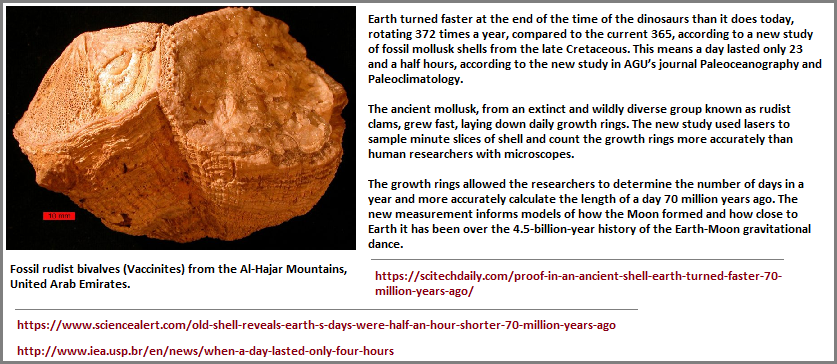
Corals from the Silurian Period, 444-419 million years ago, show 420 little lines between seasonality bands, indicating that a year during that period was 420 days long. More recent corals from the Devonian Period, a few million years later, show that the earth’s spin had slowed down to 410 days per year. (How Ancient Coral Revealed the Changing Length of a Year)
When looking at the data corresponding to the idea that the length of a day in centuries past was shorter due to a faster spinning Earth, associated events such as the proximity of the Moon do not appear to sit well when we attempt to extrapolate futher back in time using the same mathematics models being used to calculate what we believe is to be correct for shorter periods of time involving millions of years. It appears that although the rate of the Earth's rotation is slowing, the rate with which the Moon is receding from the Earth is speeding up. If we look at human behavior as a 'living timeline fossil' so-to-speak, the notion that we of today live a faster way of life appears to correlate more with the Moon than the Sun, at least in terms of the Earth's rotational speed and the Moon's positional drift which could create a huge effect on developing life forms. Like the expansion of the Universe said to be increasing, it is difficult to say whether some of our human observations are simply due to irregularites of perception caused by a need to accomodate ourselves to environmental conditions for the purposes of maintaining some semblance of survivalist equalibrium.
The next image places more of a direct timeline scale to the development of the different primates:
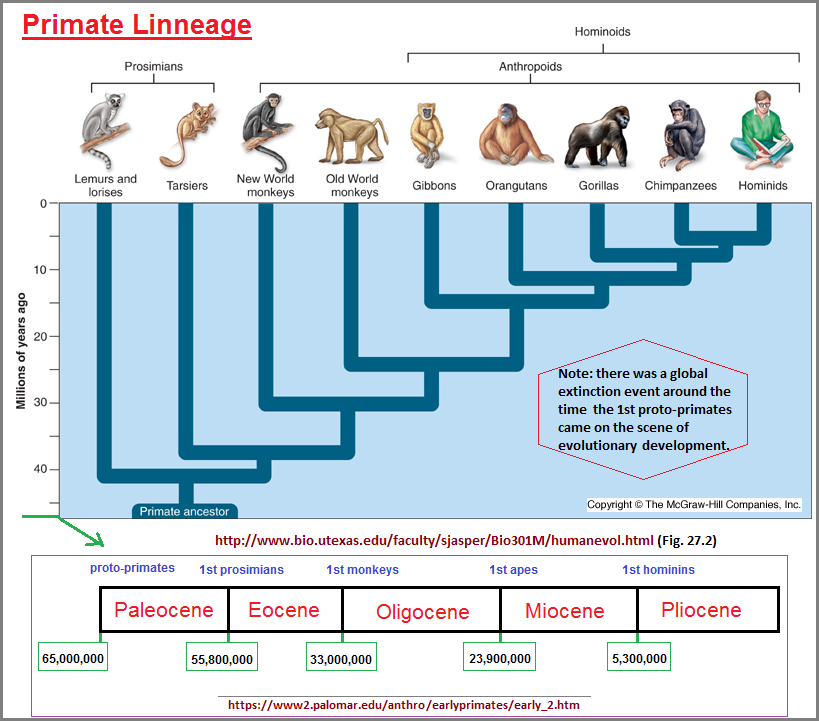
This next image correlates the idea of a changing rotation rate of the Earth with different developments involving patterns-of-three:
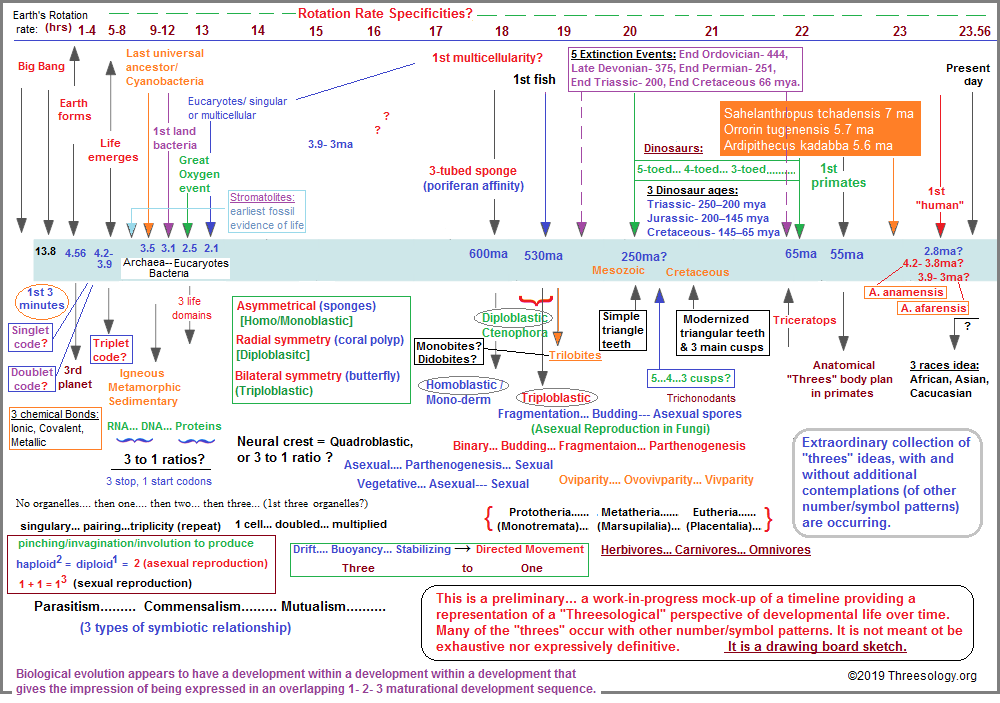
Interestingly, a researcher may customarily allow themselves to think in terms of a larger set of variables to account for differences found in different life forms, but in the present suggestion of axial tilt degrees and chromosomal count, no such open-mindedness may be forth-coming. They have to be reminded to allow for the presence of the suggested correlation and give time for more information covering a greater field of variability to unfold. In other words, give an idea the benefit of a doubt because it may be in as much of a raw state of expression as their own pet ideas. Hence, our enquiry into whether the degrees in which the Earth's tilt is positioned has an influence on chromosomal quantity involves variables involving when and where a life form arose.
For example, the complexity (or simplicity) of a life form, the environmental pressures it may be subjected to (such as at greater depths of water), oxygen availability, heat, ultra-violet radiation, proximity to other life forms, elevation, rotation rate of the Earth when a species first arose, etc., are all variables which might account for differences in chromosomal count other than simply reducing the consideration to a pure genetic one.
For example, in the context of particle physics, let us consider there first emerged a single particle which may or may not have had particle-making components preceding its debut into existence. From this single particle than arose two... let us say by way of a cleavage or splitting in two, that was followed by a third which appears to be a rebel in the family that prefers to maintain a distance to the point of exercising a type of "fringe" position like a relative, colleague or rebellious teenager, though it has a close affinity with the Proton. (Number of positively charged Protons must be equal to negatively charged Electrons.) The electron appears to garner the fringe position while the Proton and Neutron appear to share a closer bonding position due to a strong (relationship) force. However, while we might say that the Proton and Neutron both have precursor particles called (the three) Quarks, the Electron does not have and is otherwise noted as a Lepton.
The overall point being in the attempted analogy to chromosomal count is that while we might imagine a fusion of quarks to create Neutrons and Protons, we do not see a representative stepping stone to the creation of an Electron. Potential variability may occur with Protons and Neutrons due to an underlying Quark assignment, but not so with the Electron. Its variability in count (quantity), like those of the Proton and Neutron, is affected by the overall Presence or Absence of a given characteristic (placement of a positive or negative charge). The word "Presence" is related to positive and "Absence" to negative. Such are the occasions of different variables which are easier to discern when there is less roughage or weeds to wade through. Interestingly, 82 protons is the stable count for our elements. Elements with 83 and above Protons is considered unstable: Patterns of Nuclear stability
While we can speculate which form of matter arose first in existence (solid, liquid, gas... or plasma), it is thought that quarks came first: 1st matter in the universe may have been a perfect liquid, by Mara Johnson-Groh published June 02, 2021.
In providing the correlation between the Earth's tilt and it close approximation to the 23 chromosome count from each parent for humans resulting in an overall 46 chromosome count, one must wonder why such a possible environmental influence did not likewise affect all other life forms in a similar manner. No less, why do the evolutionarily born three earlier primates (Chimpanzee, Gorilla and Orangutan) have 48 chromosomes? Does this difference signal to us a difference in the tilt of the Earth's axis coupled to a different rotation rate of the Earth along with reversed polarization? Whereas the difference is said to stem from a fusion of the number 2 chromosome, what happens if the number 1 and number 3 chromosomes follow suit? Why was the number 2 chromosome susceptible to fusion while the others weren't?
...Humans have 46 chromosomes, whereas chimpanzee, gorilla, and orangutan have 48. This major karyotypic difference was caused by the fusion of two ancestral chromosomes to form human chromosome 2 and subsequent inactivation of one of the two original centromeres (Yunis and Prakash 1982). Human chromosome 2 was formed by the head-to-head fusion of two ancestral chromosomes that remained separate in other primates. Sequences that once resided near the ends of the ancestral chromosomes are now interstitially located in 2q13–2q14.1. Portions of these sequences had duplicated to other locations prior to the fusion... (Genomic Structure and Evolution of the Ancestral Chromosome Fusion Site in 2q13–2q14.1 and Paralogous Regions on Other Human Chromosomes by Yuxin Fan, Elena Linardopoulou, Cynthia Friedman, Eleanor Williams, and Barbara J. Trask1)
The idea of fusion is of interest to me because I think that the Sun's three phases/moments (dawn-noon-dusk) acted as a strobe light effect on developing biological substrates billions of years ago when the rotation of the Earth was spinning much faster, thus creating environmental circumstances similar to a rotating centrifuge used in a laboratory. Whereas we speak of micro-and macro-environments, we do not likewise add the idea of such environments being akin to test-tubes in which different substances are confined and thus intermingle as if in a spinning environment; to create a condition in which different particulate stratums accrue, like social class levels and fringe elements due to a van der waals-type of perspective.
Date of (series) Origination: Saturday, 14th March 2020... 6:11 AM
Date of Initial Posting (this page): Monday, 28th February 2022... 11:58 AM